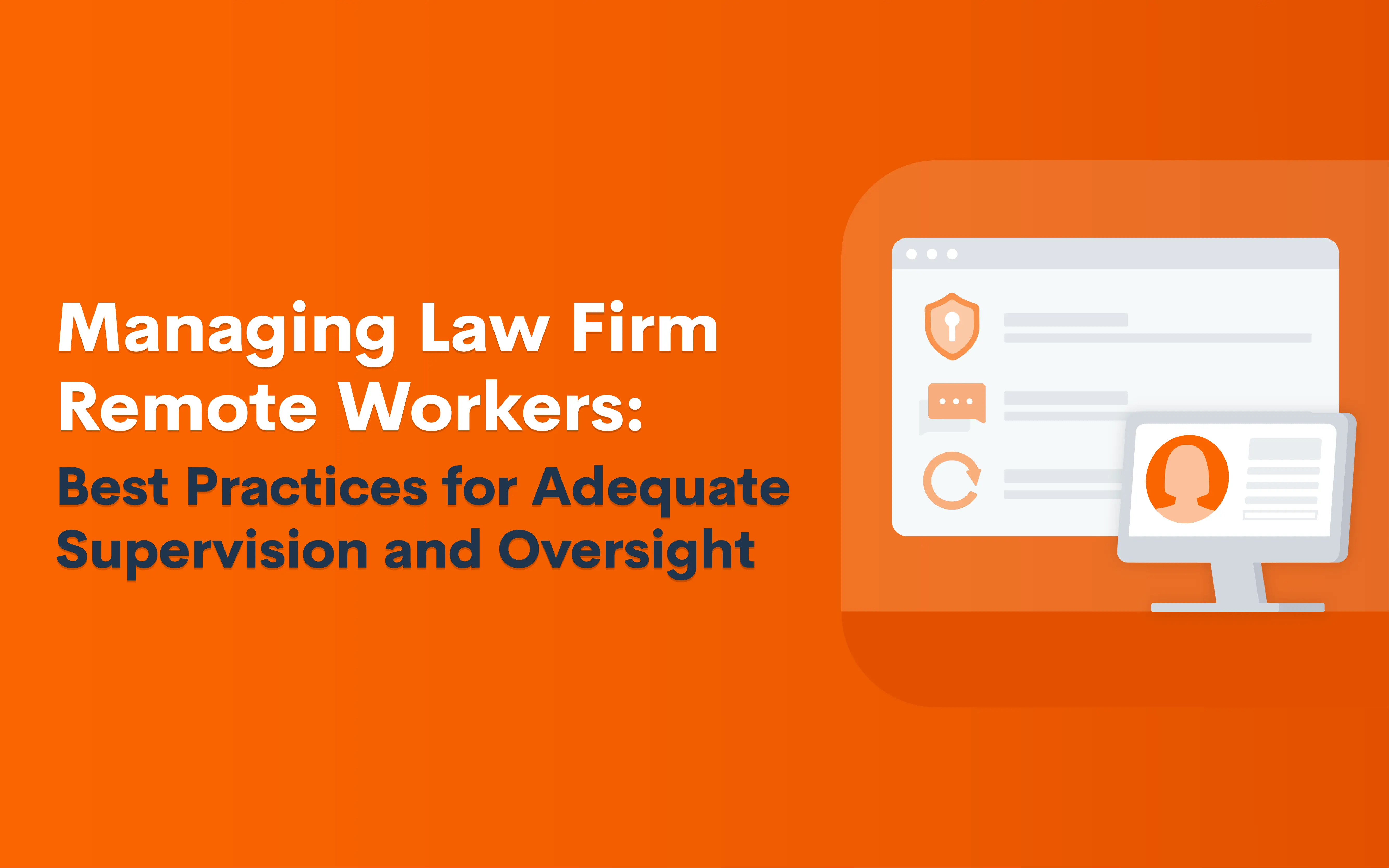Managing Law Firm Remote Workers: Best Practices for Adequate Supervision and Oversight

In the wake of the COVID-19 pandemic, many law firms transitioned to a remote work setup to keep their operations running while keeping their employees safe. While remote work has many benefits, such as increased flexibility and cost savings, it also presents unique challenges, particularly when it comes to managing and supervising remote workers. This blog post will provide law firms with best practices for ensuring adequate supervision and oversight of their remote workers, including effective communication, performance metrics, and technology solutions.
Remote work now the norm
For many law firms, remote working is no longer something new, and most have the ability to allow employees to work virtually. For some, it has been an innovative and positive experience, but others cannot wait to get back to working in an office as they miss the social aspect of a workplace and the structure it brings to the workday.
Not every role can be successfully performed remotely, even in a law firm. Every person in a business must add value, as must every position. If remote working deteriorates the person’s impact or the role, then remote working is inappropriate and needs to be refused. In scenarios such as this, the needs of the firm and the role must outweigh the needs of the individual unless a sensible and allowable workaround can be achieved.
Firms that initially had been reluctant to have employees work from home soon realized the need to be able to trust employees to get their work done remotely. Some firms even reviewed their office space requirements and considered downsizing their offices to benefit from the associated cost savings. However, managing a remote legal team will be different than supervising on-site attorneys and support teams. How can firms confidently manage remote employees without micromanaging them?
Challenges of remote law firm employees
Whether a firm’s remote employees used to work from your office or have only ever worked virtually, there will likely be challenges regarding their management. Some remote workers find the lack of face-to-face supervision results in inadequate direction. As a result, they may struggle with a lack of access to information and suffer from social isolation and distractions. A remote setting might worsen the situation if the firm practice areas are siloed.
Fortunately, these challenges can be overcome with some strategic adjustments in management style. Here are some best practices for effectively supervising remote workers:
Open communication
Regular, intentional communication is critical when managing remote employees. Here are some strategies:
Identify tools you will use to communicate. Firms must pinpoint the tools they will need to connect with remote employees, establish a pattern of regular conversations, and discuss their expectations regarding responsiveness.
Schedule regular meetings. A “standing” team meeting held at the beginning of each week to review the week ahead, along with monthly team meetings, help ensure that everyone communicates regularly.
Separate team communication from client communication. For unscheduled team communications, determine what tools you will utilize. Teams chat? Slack? Law practice management technology? Manage, organize, store, and retain client communications via email, text, and through a secure client portal.
Establish expectations for availability. Always respect people’s time. If you want your team to be available during certain times, make that known. However, is it realistic or fair to expect quick responses? Reserve messages sent after hours, on holidays, and on weekends for items worth the disruption.
Create a virtual “water cooler.” All employees, including remote ones, need to blow off steam, share information about special events, and discuss something besides work with their colleagues to forge bonds and strengthen relationships.
By clearly outlining expectations and eliminating subjectivity when measuring performance, your firm’s communication with remote employees will be more effective and less stressful, resulting in increased job satisfaction, a more robust company culture, and reduced turnover.
Provide adequate security and confidentiality
A firm cannot place the same levels of control around physical data and equipment in a remote environment as it can in the office. However, the obligation to protect and securely manage firm and client data must be at the forefront of all remote working considerations. It is the firm’s responsibility to assess the suitability of the employee’s environment and provide the necessary equipment to work remotely, whether that involves technology or office furniture.
Consequently, firms must have procedures and policies in place to protect the confidentiality of client data. This might include requiring employees to work paperless, insisting that staff members lock screens when away from their PC/laptops, and ensuring that remote employees store files securely at home.
Firms that do not provide technology to remote staff, instead requiring them to work from their own PCs and laptops, are putting client data at risk, particularly where multiple people in the household use the computer. Although secure access into the firm’s systems may be provided for convenience, many systems will automatically log in, which could pose a risk. Since the firm typically cannot ask a remote staff member to disable local saving on their own PC, this means that the moment data is saved locally, the firm is no longer in control of that data.
When a firm adopts remote working and shifts data to multiple locations, it must have strong policies, training, and monitoring in place to ensure policies and procedures are being followed. The failure to do so puts their firm and clients at risk. However, When you give remote employees the tools to perform their jobs securely, excessive oversight unnecessary.
Streamline day to day workflow
A remote employee should essentially be able to work with limited but necessary supervision and oversight. However, the firm must have policies in place to ensure adequate supervision is being provided and maintained. The failure to develop robust policies and document the oversight of remote employees could expose the firm to risk. Virtual employees must have regular contact with the office and supervisors to maintain daily communication, which can be facilitated through automation software.
Legal case management software is a helpful tool that allows law firms to automate their day-to-day processes. From managing contacts to billing and payments, it's a practical approach to managing workflows and accessing case details instead of digging through piles of paper. Case management software keeps track of all relevant information to keep everyone on the same page and provides remote employees with access whenever and wherever they need it, regardless of what computer they’re using. Team members can access an overview of all cases or details from one specific matter, all in one single location in the cloud.
When a firm with remote employees utilizes legal document automation software, it can turn template documents into intelligent, automated workflows in one easily accessible space. Not only is it extremely easy to create documents with document automation software, but employees working from anywhere can quickly review, send and receive with legal eSignature software, all in one simplified automation platform.
Protect client information
Although your firm may have accepted remote working as part of your culture, your clients might not. Because your firm has likely been a part of your local or business community for some time, your clients will be used to your presence and ease of access to your office and staff. Allowing some or all of your team to work remotely will likely impact your clients in various ways, and you need to offer reassurance that remote employees are being adequately supervised and that personally identifiable information (PII) is being protected.
Law firms cannot afford the downtime and client data exposure that comes with lax security, which is why agile technology platforms provide state of the art security features to protect clients. Look for systems hosted by Amazon Web Services’ Industry Standard Security, which provides the state-of-the-art security demanded by corporations like Netflix, NASDAQ, and Liberty Mutual. Ensure that the platform you choose stores your firm’s data at 256-bit AES encryption, the standard banks and large financial institutions use. Two-factor authentication is essential to keep firm data secure at all times from all locations, and regular backups ensure that your account will be accessible at any time.
Automate routine tasks
Documented workflows and tasks are essential tools for the efficient management of a remote workforce. Haphazard emails, sticky notes, voicemail messages, and simply dropping by someone’s desk to give them an assignment no longer cut it. These rudimentary practices do little to ensure that tasks will be documented and completed and offer little to no visibility regarding projects and deadlines, reporting on progress, or documented accountability. Fortunately, there are many technological applications available to firms that will increase transparency, productivity, and accuracy.
A legal client relationship management tool (CRM) automates and streamlines tasks that would otherwise require tedious manual processes and time lost. Regardless of their practice area, nearly every lawyer spends a large portion of their workweek on menial administrative tasks, which are an inevitable part of running a practice. Legal CRM software takes the headache out of client management tasks like follow-up, manual entry of client data, generating complex legal documents, and lengthy back-and-forths for appointment scheduling and marketing the firm.
Trying to find a time that works for everyone’s busy schedules is time-consuming, especially when not everyone is working from the same place. Legal calendar software for lawyers allows all team members (in-house and remote) to simply sync their Outlook or Google calendar and allow clients to choose a meeting time that works around the lawyer or firm’s existing schedule. Any timeslot with an existing calendar event will be blocked off, and clients will only see the available time slots. All the team will have to do is check the calendar - no more wasting time playing phone tag and ensuring that everyone is on the same page without unnecessary oversight.
Provide mentorship
To manage remote employees effectively, you must be committed to your team’s success. Leading a remote team requires embracing an attitude of thoughtful engagement, celebrating accomplishments, providing help as necessary, being an active listener, and remaining present for those reporting to you.
Law firms are hectic, demanding, and taxing workplaces. However, when you provide support in the form of mentorship, remote workers will be more likely to seek your advice and not become frustrated when they struggle. Whether your team works entirely remotely, has a hybrid arrangement, or comes to the office every day, implementing best practices in managing a remote workforce will improve transparency, engagement, productivity, and success.
The right technology makes management without micromanagement possible
Although employee monitoring software became a cottage industry during the pandemic, that does not mean it is a good idea. According to a 2021 ExpressVPN survey, 54 percent of the respondents said they would likely quit their jobs if they learned of workplace monitoring. Firms considering deploying technology to track remote employee work must realize that while a person may be seen by management at their office desk, it never meant that they were actively working.
For many law firms, remote working has become a reality. Yet, no employee wants to feel micromanaged or distrusted. However, through effective communication and adequate support, tracking technology will not be necessary. Instead, firms that have the appropriate policies, procedures, and law firm technology solutions in place will embrace this relatively new way of working to boost firm productivity and allow employees to enjoy a healthier work-life balance.
Lawmatics automation software is the best solution for keeping everything flowing exactly the way it should be. No more worrying about whether a client has been followed up with or frantically searching for important documents. Instead, keep everything in one centralized location that anyone in your firm can access from anywhere. Say goodbye to day-to-day chaos and take control of your firm’s workflow with Lawmatics legal CRM and client intake software. The end result: a frictionless experience for both you and your clients, along with happier employees and more referrals. Ready to learn more about the Lawmatics platform? Get a demo today.


